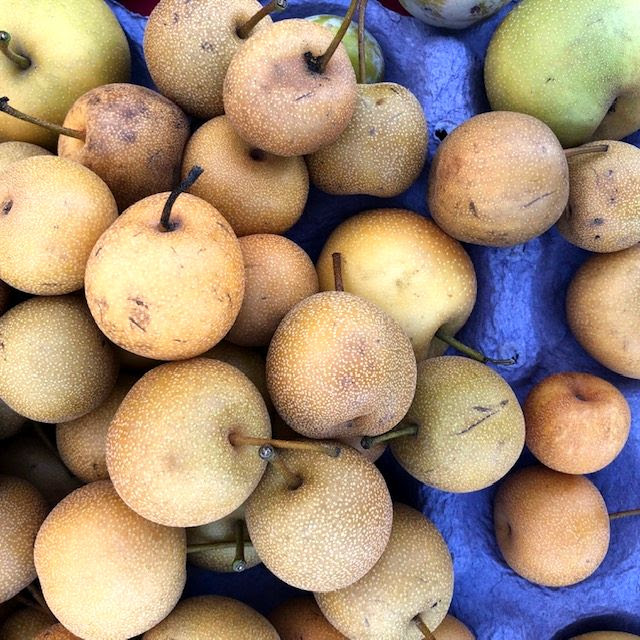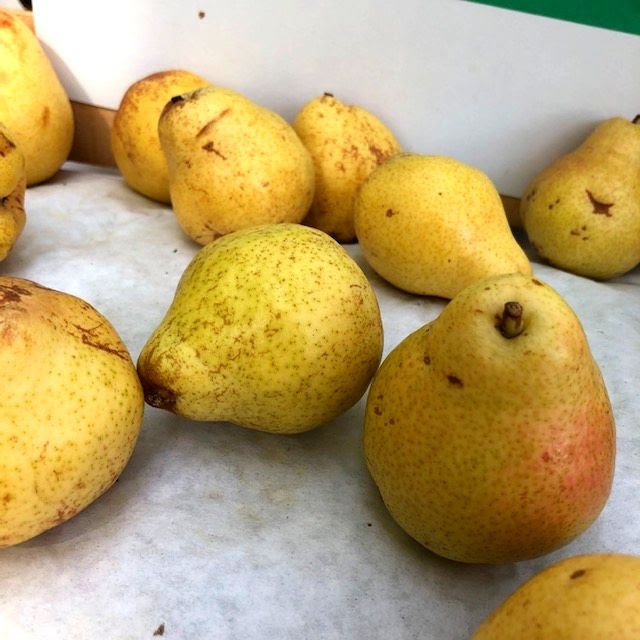In season from late summer through early spring (depending on the type and the region), pears are one fruit that we can’t get enough of! They come in so many varieties, are so versatile, taste SO GOOD, and are one of the few fruits that improve off the tree. You can pick them while still hard and allow them to ripen on the counter for a sweet, succulent addition to all sorts of fall dishes. They also boast more fiber, potassium, and folate than apples. Need we say more?
Be pre-peared to crave these juicy, buttery beauties after this weeks guide but don’t worry – there are plenty at the market!
- pear2
At Home Tips and Tricks
Sure you could just eat them out of hand, but there are so many other (delicious) ways to enjoy pears. Popular cooking methods include poaching (in wine, syrup, fruit juice, water) and baking. Pears are amazing in baked goods like tarts, pies, and cakes, as well as in jams, preserves, and chutneys. And because they are related to apples, it’s generally understood that if a recipe calls for apples, pears can be substituted. Warm spices like cinnamon, nutmeg, and ginger complement the fruit in both edible and drinkable recipes.
Look for Pears that are Firm and Bruise-Free
Choose pears that are firm to the touch and don’t have bruises or cuts. Some pears are wrapped in paper, which protects the pears and helps keep them unblemished. Note that the Bartlett is the only variety that will change color when ripe, so purchase when green.
Store Your Pears
Pears will continue to ripen off the tree. Leave your pears on the counter for a few days to ripen at room temperature. Bartletts will turn yellow when ripe. Other pears will have a slight softness on the stem end when ready. Once ready, pears can be refrigerated to slow the ripening
process. When perfectly ripe, use within five days. To ripen them quickly at home, put hard fruit in a punctured paper bag and keep it at room temperature until the fruit is aromatic and gives slightly when pressed with your thumb. But beware: Pears ripen very quickly! Overripe pears are pulpy and the flesh will be mealy.
Peel and Core Before Cooking
Wash pears well, taking extra care to clean the stem ends, even if you plan to peel them. Carefully cut and core them with a paring knife. You can choose to peel pears before cooking them, as their skin grows tough when heated.
Use Lemon to Prevent Sliced Pears from Browning
Prevent premature browning by dipping cut pears in acidulated water (water mixed with a little lemon juice or vinegar). This works on European pears such as the Bartlett and Comice but not on Asian pears.
- pear3
Some Common Varieties
All types of pears can be divided into two simple categories: European and Asian. The former is what we typically think of: a smooth-skinned fruit with gentle bumps and curves in that typical bottom-heavy shape. Asian pears are uniform in color (yellowish-tan) and shaped more like apples, with a completely different texture and taste. Asian pears do not change color after being harvested, whereas some European ones do.
Bartlett
An early ripening pear with a sturdy shelf life, delicious in salads, eaten out of hand, pr baked. They have delicate, thin skin and a juicy bite, and can be both yellowish-green or red.
Anjous
Both red and green, they are short, squat, and plump, with a luscious white flesh that gets even sweeter a few weeks off the tree. Best eaten raw.
Bosc
This long neck brown pear is crisp and holds up beautifully when poached in red wine or baked in a buttery pear tart. The flesh is white, sweet, and firm.
Seckel (also known as the Sugar Pear)
Spicy and aromatic but petite – a wonderful choice for a blue cheese, walnut, and frisée salad.
Comice
Succulent sweetness and custardy texture, perfect for a simple dessert.
Asian Pears
Apple-shaped and crisp (bordering on crunchy). The skin’s texture is a little gritty and not as soft as that of other pears. The Asian pear is ripe when it’s firm, not when it becomes more pliable to the touch. Take advantage of the Asian pear’s characteristics by eating it raw and in salads and slaws.
This is a small sampling of the more common pears you will find – but get out there and explore! Pear up with The Chico Certified Farmers’ Market to find new and exciting varieties this Saturday!


